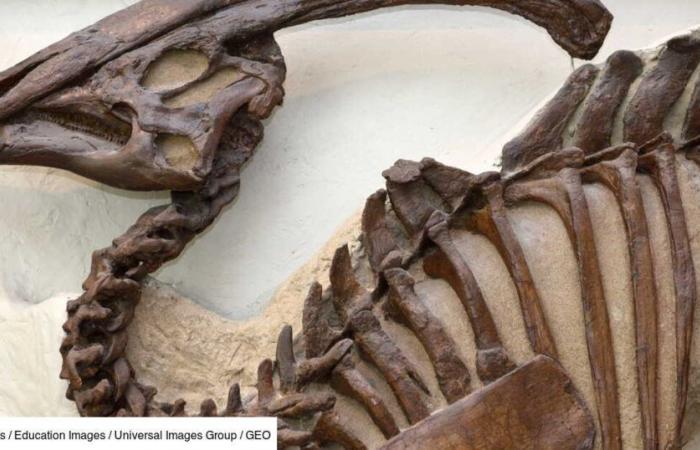From the dinosaurs that roamed the Earth millions of years ago, the legacy carved into the rocks offers paleontologists insight into their physical traits and lifestyles. But the sounds they once produced remain more mysterious. At the beginning of 2023, the study of the fossilized larynx of a specimen of the ankylosaur family (Ankylosaurus) revealed that he could have pushed “loud, explosive cries as in reptiles and vocal birds”.
Today, creating a model inspired by the distinctive crest of a Parasaurolophus could give new insights into the sounds emitted by these giant creatures. The results obtained by the New York University researchers were presented at the 187th meeting of the Acoustical Society of America, which took place from November 18 to 22, 2024.
What did the Parasaurolophus ?
The Parasaurolophus was a herbivorous dinosaur that lived during the Late Cretaceous Period, approximately 70 to 80 million years ago. A true giant, it could reach heights of around 5 meters and weigh more than 3 tonnes. It belonged to the group of hadrosaurids (Hadrosauridae), often called “duck-billed dinosaurs” because of their flattened snouts. But perhaps its most distinctive feature was its large hollow bony crest, shaped like a tube curved towards the back of its skull, which could reach 1.8 meters in length.
For a long time, this curved ridge has intrigued. Some have hypothesized that it could have been used for a super sense of smell, an underwater respiratory system, for regulating body temperature, or even for recognition purposes between individuals.
More recent research on fossils of Parasaurolophus However, seem to suggest that it was most likely used to produce sounds… which we have no idea what they sounded like, as researcher Hongjun Lin, author of the new study, indicates.
Fascinated since childhood by these giant extinct animals, which he loves to watch in works of fiction, it was only at university that he understood that “the sounds we hear in films and series – although captivating – are entirely made from modern animal sounds”he explains in a press release. “That’s when I decided to delve deeper and explore what dinosaurs might have actually sounded like sonically.”
The “Linophone” to reveal your “voice”
To understand the acoustic properties of the crest of the Parasaurolophushe and his colleagues created a physical model that mimicked the structure – nicknamed the “Linophone”. It is made up of tubes, arranged to reproduce its hollow chambers. It is not an exact replica, it is specified. “I wanted something simplified and accessible, both for modeling and building a physical device”indicates the specialist.
The model, on a 1:3 scale compared to the fossil of Parasaurolophus “reproduced”, was 3D printed and delicately hung using cotton threads. A small speaker introduced sound vibrations into the structure, while a microphone picked up the resulting frequencies. By analyzing how sound waves traveled through the hollow tubes of the dinosaur’s crest, the researchers were able to observe that they functioned as resonance chambers, amplifying the dinosaur’s vocalizations.
The latter thus undoubtedly used its crest to produce resonant sounds, like modern birds. Much like a wind musical instrument, air passing through the tubes created sound vibrations, which could be amplified and modified by the protrusion. In cranes or swans, for example, such bodily structures (air sacs, specialized bones) serve, in the same way, as natural resonators, making it possible to amplify their song or emit low-pitched calls that carry over long distances.
Understanding the acoustic principles of ridge
Maybe the Parasaurolophus did it emit calls to attract a partner, warn its group of danger, locate itself in a dense environment, show its dominance or recognize members of its species. These are just hypotheses.
While waiting to decipher this mystery, experts from New York University are working on a mathematical model, a computer simulation that could help them better visualize and test the acoustic principles at play and thus understand how the ridge actually works. .
Hongjun Lin hopes it will prove useful for studying creatures with similar vocal structures. He also plans to create a plug-inso people can experiment and add dinosaur sounds to music – that of John Williams, for example, composer of Jurassic Park. “Once we have a working model, we will move on to analyzing the fossils. My ultimate goal is to recreate the sound of Parasaurolophus“he concludes.






